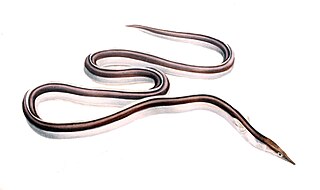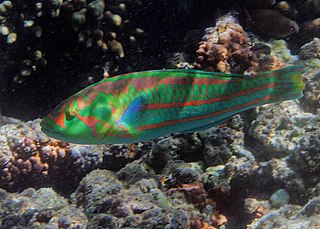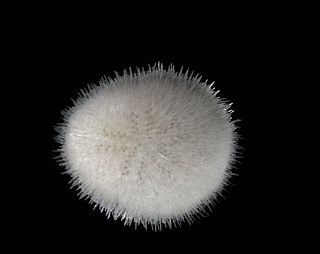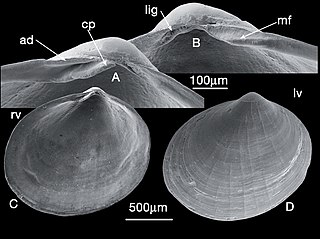
Sea urchins or urchins are typically spiny, globular animals, echinoderms in the class Echinoidea. About 950 species live on the seabed, inhabiting all oceans and depth zones from the intertidal to 5,000 metres. Their tests are round and spiny, typically from 3 to 10 cm across. Sea urchins move slowly, crawling with their tube feet, and sometimes pushing themselves with their spines. They feed primarily on algae but also eat slow-moving or sessile animals. Their predators include sea otters, starfish, wolf eels, and triggerfish.

The red sea urchin is a sea urchin found in the northeastern Pacific Ocean from Alaska to Baja California. It lives in shallow waters from the low-tide line to greater than 280 m (920 ft) deep, and is typically found on rocky shores sheltered from extreme wave action in areas where kelp is available.

The serpent eel or sand snake-eel is an eel found in the eastern Atlantic Ocean, western Mediterranean Sea, western Indian Ocean, western Pacific Ocean and the north-east and west coast of North Island in New Zealand. It is an elongated, slender fish with a length of up to 250 centimetres. It spends the day with its body immersed in the sediment, emerging into the open water at night.

Kina is a sea urchin endemic to New Zealand. This echinoderm belongs to the family Echinometridae and it can reach a maximum diameter of 16–17 cm.

Echinus esculentus, the European edible sea urchin or common sea urchin, is a species of marine invertebrate in the Echinidae family. It is found in coastal areas of western Europe down to a depth of 1,200 m (3,900 ft). It is considered "Near threatened" in the IUCN Red List of Threatened Species.

Lytechinus variegatus, commonly called the green sea urchin or the variegated sea urchin, is a species of sea urchin that can be found in the warm waters of the western Atlantic Ocean and Caribbean Sea.

The surge wrasse, also known as the green-blocked wrasse, purple wrasse or red and green wrasse, is a species of wrasse native to the southeast Atlantic Ocean through the Indian and Pacific Oceans, where it inhabits reefs and rocky coastlines in areas of heavy wave action at depths from the surface to 10 m (33 ft). This species is of minor importance to local commercial fisheries, is popular as a game fish, and can be found in the aquarium trade.

Spatangus is a genus of heart urchins in the Spatangidae family. The genus is synonymous with the previously recognised genera Prospatangus Lambert, 1902 and Spatagus. There are nine recognised species. The type species is Spatangus purpureus Müller, 1776 by subsequent designation.

Paracentrotus lividus is a species of sea urchin in the family Parechinidae commonly known as the purple sea urchin. It is the type species of the genus and occurs in the Mediterranean Sea and eastern Atlantic Ocean.

Psammechinus miliaris is a species of sea urchin in the family Parechinidae. It is sometimes known as the green sea urchin or shore sea urchin. It is found in shallow areas of the eastern Atlantic Ocean and the North Sea.

Sphaerechinus granularis is a species of sea urchin in the family Toxopneustidae, commonly known as the violet sea urchin, or sometimes the purple sea urchin. Its range includes the Mediterranean Sea and eastern Atlantic Ocean.

Ophiocomina nigra, commonly known as the black brittle star or black serpent star, is a species of marine invertebrate in the order Ophiurida. It occurs in the north-eastern Atlantic Ocean, the North Sea, and the Mediterranean Sea.

Echinus melo, melon sea urchin, is a species of sea urchin in the family Echinidae.

Centrostephanus longispinus, the hatpin urchin, is a species of sea urchin in the family Diadematidae. There are two subspecies, Centrostephanus l. longispinus, found in the eastern Atlantic and Mediterranean Sea and Centrostephanus l. rubricingulus, found in the western Atlantic.

Cidaris cidaris is a species of sea urchin commonly known as the long-spine slate pen sea urchin. It is found in deep water in the eastern Atlantic Ocean and the Mediterranean Sea.

Brissus unicolor is a species of sea urchins of the family Brissidae. Their armour is covered with spines. Brissus unicolor was first scientifically described in 1778 by Nathanael Gottfried Leske.

Isotealia antarctica, the salmon anemone, is a species of sea anemone in the family Actiniidae. It is found in the southern Atlantic and Pacific Oceans and the waters around Antarctica. It is a filter feeder and opportunistic predator.

Lutjanus purpureus, the southern red snapper or Caribbean red snapper, is a species of marine ray-finned fish, a snapper belonging to the family Lutjanidae. It is native to the western Atlantic Ocean as well the Caribbean Sea.

Echinocyamus pusillus, commonly known as the pea urchin or green urchin, is a species of sand dollar, a sea urchin in the family Fibulariidae, native to the northeastern Atlantic Ocean and the Mediterranean Sea. It buries itself in gravel or coarse sand at depths down to about 1,250 m (4,000 ft).

Montacuta substriata is a species of small marine bivalve mollusc in the family Lasaeidae. It is found on the eastern side of the Atlantic Ocean where it is often associated with a sea urchin, such as Spatangus purpureus. This species was first described in 1808 by the English naturalist George Montagu who gave it the name Ligula substriata. It was later transferred to the genus Montacuta, making it Montacuta substriata.




















